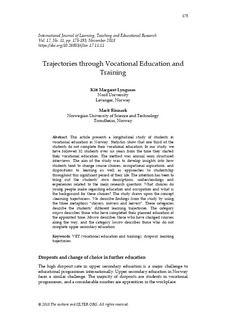| dc.contributor.author | Lyngsnes, Kitt Margaret | |
| dc.contributor.author | Rismark, Marit | |
| dc.date.accessioned | 2019-04-10T08:27:26Z | |
| dc.date.available | 2019-04-10T08:27:26Z | |
| dc.date.created | 2019-01-02T10:38:01Z | |
| dc.date.issued | 2018 | |
| dc.identifier.citation | International Journal of Learning, Teaching and Educational Research. 2018, 17 (11), 175-193. | nb_NO |
| dc.identifier.issn | 1694-2116 | |
| dc.identifier.uri | http://hdl.handle.net/11250/2593976 | |
| dc.description.abstract | This article presents a longitudinal study of students in vocational education in Norway. Statistics show that one third of the students do not complete their vocational education. In our study, we have followed 32 students over six years from the time they started their vocational education. The method was annual semi structured interviews. The aim of the study was to develop insights into how students tend to change course choices, occupational aspirations, and dispositions to learning as well as approaches to studentship throughout this significant period of their life. The intention has been to bring out the students’ own descriptions, understandings and experiences related to the main research question: What choices do young people make regarding education and occupation and what is the background for these choices? The study draws upon the concept «learning trajectories». We describe findings from the study by using the three metaphors “stayers, movers and leavers”. These categories describe the students’ different learning trajectories. The category stayers describes those who have completed their planned education at the appointed time. Movers describes those who have changed courses along the way, and the category leavers describes those who do not complete upper secondary education. | nb_NO |
| dc.language.iso | eng | nb_NO |
| dc.publisher | Tresorix | nb_NO |
| dc.rights | Attribution-NonCommercial-NoDerivatives 4.0 Internasjonal | * |
| dc.rights.uri | http://creativecommons.org/licenses/by-nc-nd/4.0/deed.no | * |
| dc.title | Trajectories through vocational education and training | nb_NO |
| dc.type | Journal article | nb_NO |
| dc.type | Peer reviewed | nb_NO |
| dc.description.version | publishedVersion | nb_NO |
| dc.source.pagenumber | 175-193 | nb_NO |
| dc.source.volume | 17 | nb_NO |
| dc.source.journal | International Journal of Learning, Teaching and Educational Research | nb_NO |
| dc.source.issue | 11 | nb_NO |
| dc.identifier.doi | 10.26803/ijlter.17.11.11 | |
| dc.identifier.cristin | 1648299 | |
| dc.description.localcode | © 2018 The authors and IJLTER.ORG. All rights reserved. | nb_NO |
| cristin.unitcode | 194,67,70,0 | |
| cristin.unitname | Institutt for pedagogikk og livslang læring | |
| cristin.ispublished | true | |
| cristin.fulltext | original | |
| cristin.qualitycode | 1 | |

